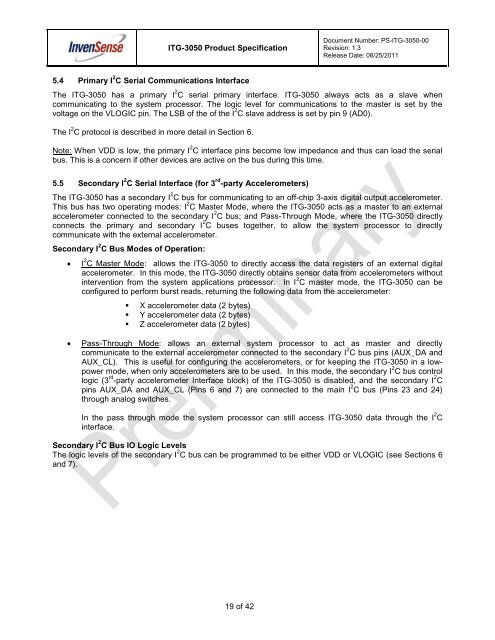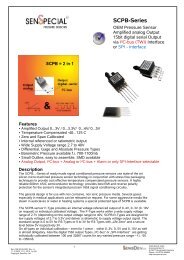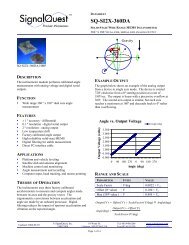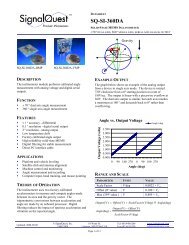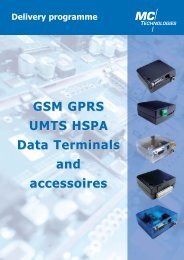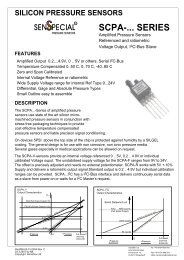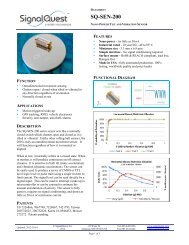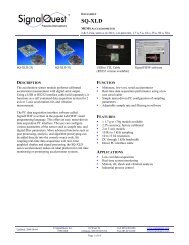ITG-3050 Product Specification Revision 1.3 - InvenSense
ITG-3050 Product Specification Revision 1.3 - InvenSense
ITG-3050 Product Specification Revision 1.3 - InvenSense
Create successful ePaper yourself
Turn your PDF publications into a flip-book with our unique Google optimized e-Paper software.
<strong>ITG</strong>-<strong>3050</strong> <strong>Product</strong> <strong>Specification</strong><br />
Document Number: PS-<strong>ITG</strong>-<strong>3050</strong>-00<br />
<strong>Revision</strong>: <strong>1.3</strong><br />
Release Date: 08/25/2011<br />
5.4 Primary I 2 C Serial Communications Interface<br />
The <strong>ITG</strong>-<strong>3050</strong> has a primary I 2 C serial primary interface. <strong>ITG</strong>-<strong>3050</strong> always acts as a slave when<br />
communicating to the system processor. The logic level for communications to the master is set by the<br />
voltage on the VLOGIC pin. The LSB of the of the I 2 C slave address is set by pin 9 (AD0).<br />
The I 2 C protocol is described in more detail in Section 6.<br />
Note: When VDD is low, the primary I 2 C interface pins become low impedance and thus can load the serial<br />
bus. This is a concern if other devices are active on the bus during this time.<br />
5.5 Secondary I 2 C Serial Interface (for 3 rd -party Accelerometers)<br />
The <strong>ITG</strong>-<strong>3050</strong> has a secondary I 2 C bus for communicating to an off-chip 3-axis digital output accelerometer.<br />
This bus has two operating modes: I 2 C Master Mode, where the <strong>ITG</strong>-<strong>3050</strong> acts as a master to an external<br />
accelerometer connected to the secondary I 2 C bus; and Pass-Through Mode, where the <strong>ITG</strong>-<strong>3050</strong> directly<br />
connects the primary and secondary I 2 C buses together, to allow the system processor to directly<br />
communicate with the external accelerometer.<br />
Secondary I 2 C Bus Modes of Operation:<br />
<br />
I 2 C Master Mode: allows the <strong>ITG</strong>-<strong>3050</strong> to directly access the data registers of an external digital<br />
accelerometer. In this mode, the <strong>ITG</strong>-<strong>3050</strong> directly obtains sensor data from accelerometers without<br />
intervention from the system applications processor. In I 2 C master mode, the <strong>ITG</strong>-<strong>3050</strong> can be<br />
configured to perform burst reads, returning the following data from the accelerometer:<br />
• X accelerometer data (2 bytes)<br />
• Y accelerometer data (2 bytes)<br />
• Z accelerometer data (2 bytes)<br />
<br />
Pass-Through Mode: allows an external system processor to act as master and directly<br />
communicate to the external accelerometer connected to the secondary I 2 C bus pins (AUX_DA and<br />
AUX_CL). This is useful for configuring the accelerometers, or for keeping the <strong>ITG</strong>-<strong>3050</strong> in a lowpower<br />
mode, when only accelerometers are to be used. In this mode, the secondary I 2 C bus control<br />
logic (3 rd -party accelerometer Interface block) of the <strong>ITG</strong>-<strong>3050</strong> is disabled, and the secondary I 2 C<br />
pins AUX_DA and AUX_CL (Pins 6 and 7) are connected to the main I 2 C bus (Pins 23 and 24)<br />
through analog switches.<br />
In the pass through mode the system processor can still access <strong>ITG</strong>-<strong>3050</strong> data through the I 2 C<br />
interface.<br />
Secondary I 2 C Bus IO Logic Levels<br />
The logic levels of the secondary I 2 C bus can be programmed to be either VDD or VLOGIC (see Sections 6<br />
and 7).<br />
19 of 42


